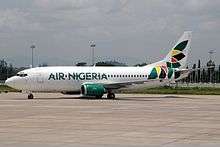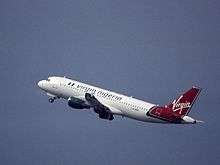Air Nigeria
 | |||||||
| |||||||
| Founded | 2004 (as Virgin Nigeria) | ||||||
|---|---|---|---|---|---|---|---|
| Commenced operations | 28 June 2005 | ||||||
| Ceased operations | 10 September 2012 | ||||||
| Operating bases | Murtala Muhammed International Airport | ||||||
| Frequent-flyer program | Eagleflier | ||||||
| Fleet size | 12 | ||||||
| Destinations | 19 | ||||||
| Parent company |
| ||||||
| Headquarters | Ikeja, Lagos State, Nigeria | ||||||
| Key people | |||||||


Air Nigeria (originally Virgin Nigeria Airways, and then Nigerian Eagle Airlines), was the national flag carrier of Nigeria,[1] which operated scheduled regional and domestic passenger services. The airline's base was Murtala Mohammed International Airport in Ikeja, its head office was in Lagos Island, Lagos and the C&M building in Crawley,[2] and its registered office was in Ikoyi, Lagos.[3]
The airline, which effectively replaced the defunct Nigeria Airways, was founded in 2004 as a joint venture between Nigerian investors and the Virgin Group. Virgin withdrew from the business during 2008-2010. Following two name changes, Air Nigeria announced on 6 September 2012 that it had fired employees and ceased operations on 10 September 2012.[4]
History
Origins
On 28 September 2004, the Nigerian government and Virgin Group signed an agreement to establish a new airline for Nigeria, to be called Virgin Nigeria Airways. Nigerian institutional investors owned 51% of the company and Virgin Atlantic Airways the remaining 49%. The airline's inaugural flight was on 28 June 2005 from Lagos to London Heathrow, using an Airbus A340-300 aircraft. Virgin Nigeria quickly became one of Nigeria's largest airlines, carrying its 1,000,000th passenger and 4,000th ton of freight within two years of operation. The airline has also received accolades including THISDAY Awards 2006 Airline of the year[5] and a nomination for 2006 African Airline of the year by ASATA (Association of South African Travel Agents).[6] Virgin Nigeria had plans to make Nnamdi Azikiwe International Airport in Abuja its second base, where, in addition to its Lagos base Murtala Muhammed International Airport, it would serve all countries in West Africa.[7]
The Nigerian government set a deadline of 30 April 2007 for all airlines operating in the country to re-capitalise or be grounded, in an effort to ensure better services and safety. The airline satisfied the Nigerian Civil Aviation Authority (NCAA)’s criteria in terms of re-capitalization and was re-registered for operation.[8]
Sale of Virgin's stake and rebranding

On 19 August 2008, Virgin Atlantic announced that it was "in talks to sell its 49 percent stake in Virgin Nigeria" and reviewing "whether it is appropriate that the Virgin brand should remain linked to Virgin Nigeria”.[9] This followed a dispute which arose after Virgin Nigeria's domestic operations were moved against its will by the Ministry of Transportation to Terminal 2. Virgin Nigeria had twice refused the directive to relocate its domestic operations from the international terminal, citing the Memorandum of Mutual Understanding it had signed with the previous (Olusegun Obasanjo) administration, and pending appeal in a Lagos High court, as reasons for not complying.
On 9 January 2009, Virgin Nigeria announced they would suspend all long haul flights to London Gatwick Airport and Johannesburg, effective 27 January 2009.[10]
On 17 September 2009, Virgin Nigeria announced on their website they had rebranded as Nigerian Eagle Airlines. Nigerian Eagle Airlines also stated that they planned to focus on domestic and regional flights with further expansion into Europe and eventually the United States of America.[11] Virgin retained its 49% stake in the new Nigerian Eagle Airlines with the remaining 51% held by Nigerian investors.
Rebranding as Air Nigeria, and cessation of operations
On 2 June 2010, following the acquisition of a majority share in the airline, Jimoh Ibrahim, the new Chairman, announced that the airline had undergone a further name change to Air Nigeria Development Limited, branded as Air Nigeria.[12] On 13 June 2012, the carrier was grounded by regulators for safety checks.[13]
On 6 September 2012 Air Nigeria announced that the management had fired its staff 'for being disloyal' and the airline will cease all its local, regional and international operations.[14] Operations ceased on 10 September 2012.[4]
Destinations
Codeshare agreements
Fleet

Closing fleet
The Air Nigeria fleet consisted of the following aircraft shortly before it ceased operations (as of April 2012):[18]
| Aircraft | In Fleet | On Order | Passengers | Note | ||
|---|---|---|---|---|---|---|
| J | Y | Total | ||||
| Airbus A330-200 | 2 | 0 | 24 | 244 | 268 | Leased from EgyptAir |
| Boeing 737-300 | 8 | 0 | 16 | 100 | 116 | |
| Boeing 737-400 | 1 | 0 | ||||
| Embraer E-190 | 2 | 0 | 12 | 84 | 96 | |
| Total | 13 | 0 | ||||
Historic fleet

Before rebranding, Virgin Nigeria had also operated the following aircraft:[19]
| Aircraft | Total | Introduced | Retired | Notes |
|---|---|---|---|---|
| Airbus A320-211 | 2 | 2005 | 2007 | Leased from BH Air |
| Airbus A330-200 | 3 | 2007 | 2007 | Leased from bmi |
| Airbus A340-300 | 2 | 2005 | 2006 | Leased from Virgin Atlantic Airways |
| ATR 42-500 | 1 | 2008 | 2009 | Leased from Interstate Airlines |
| Boeing 737-300 | 2 | 2005 | 2007 | Leased from GECAS |
| Boeing 767-300ER | 2 | 2007 | 2009 | Leased from SmartLynx Airlines |
| Fokker 50 | 2 | 2007 | 2008 | Leased from Denim Air |
See also
References
- ↑ "Air Nigeria ends international flights." Retrieved on 11 December 2012.
- ↑ "Registered Office." Air Nigeria. Retrieved on 21 May 2012. "159/161 Broad Street, Marina Lagos Island Lagos, Nigeria."
- ↑ "AN Registered Offices." Air Nigeria. Retrieved on 28 June 2010. "Registered Office 188 Awolowo Road South West Ikoyi Lagos, Nigeria. Head Office 9th Floor Etiebets Place 21, Mobolaji Bank-Anthony Way Ikeja Lagos, Nigeria. "
- 1 2 Brock, Joe. "Air Nigeria shuts down in latest aviation setback". Reuters. Retrieved 10 September 2012.
- ↑ Virgin Nigeria wins 2006 Airline of the Year award., AllAfrica.com website, retrieved March 27, 2007
- ↑ Virgin Nigeria nominated for 2006 African Airline of the year, Association of South African Travel Agents website, retrieved 27 March 2007
- ↑ Virgin Nigeria buys bevy of Embraer regional jets: AINonline Archived 2007-12-27 at the Wayback Machine.
- ↑ Nigeria Direct Archived February 14, 2008, at the Wayback Machine. 2 May 2007
- ↑ Virgin in talks to sell out of Nigeria
- ↑ Flights Have Now Finished
- ↑ Virgin Nigeria Rebrand As Nigerian Eagle Airlines
- ↑ Nigerian Eagle Airlines Rebrands As Air Nigeria
- ↑ http://www.businessweek.com/ap/2012-06/D9VCD5F02.htm
- ↑ Hope of Air Nigeria’s return dims as AOC expires
- ↑ Nigerian Eagle Airlines signs Codeshare with Kenya Airways
- ↑ Nigerian Eagle Signs Code-share Deal with Delta
- ↑ Delta Starts Codeshare Flights with Air Nigeria
- ↑ Air Nigeria Fleet
- ↑ Virgin Nigeria Past Fleet
External links
![]() Media related to Air Nigeria at Wikimedia Commons
Media related to Air Nigeria at Wikimedia Commons